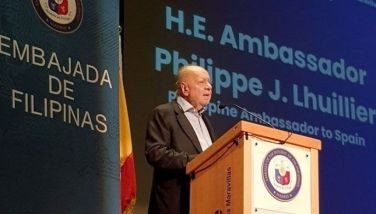Cebu faces dry tap quarrels in 10 years
March 23, 2003 | 12:00am
If the feet-dragging continues, Cebu could confront, in just 10 years, escalating riots over salt-contaminated wells and dry taps.
Water Resources Center scientists say this bleak prospect faces Cebu as over 180 countries "distracted by the Iraq conflict" marked the United Nations-sponsored "World Day for Water" the other day.
San Carlos University’s WRC first studied, in 1965, the first signs of sea water intrusion into Metro Cebu’s main source of water – a narrow elongated limestone aquifer.
This "saline edge" advances relentlessly at more than 150 meters yearly. It has seeped beyond the provincial capitol. And the edge brushes against Cebu’s foothills.
"The saline water edge has already moved three kilometers inland," an Ayala Land study noted in 1995.
It added: "In coming years, this will cause an increase in groundwater salinity beyond a permissible level (250 mg C1/liter)… Groundwater from this portion of the coastal aquifer will become non-potable... and will cause a crisis in Cebu."
That is coming to pass. Salination rate accelerated as emergency wells "built in the 1980s to bridge failure to build a high dam suggested by the World Bank in 1976" overpump limited aquifers.
"The present capacity of the coastal aquifer is 150,000 cubic meters daily," WRC’s Fe Walag said. "But actual pumping is double that or 300,000 cubic meters per day. This is not sustainable."
It can take 500 or more years to flush salt-damaged aquifers. So, Metro Cebu’s water source, along the coast, is being irreversibly turned today, chunk after chunk, into brackish unusable cesspools.
"Systematic observations on this intrusion, since 1975, show that in 2025, half of the coastal aquifer will be permanently lost," WRC director Fr. Herman van Engelen warned.
Irreversibly damaged aquifers now interlock with the late former President Ferdinand Marcos’ decision, in the 1970s, to freeze national funds to build the World Bank-suggested dam.
That project would have benefited Marcos’ rival then, the late Mayor Sergio Osmeña Jr. It would have staved off today’s shortages by providing Cebu with an additional 150,000 cubic meters of water daily.
Migration and births have boosted population in Metro Cebu to over 1.7 million, the last headcount shows. And demand for water by industries has multiplied.
To partially close this widening gap, Cebuanos jerry-rigged emergency measures. They have built Phase 1 of a 25,000 cubic meter-dam while residents drilled well after well into Cebu’s strained aquifers.
These temporary measures have become permanent as local officials fail to muster the political will to make hard decisions.
"People in the area serviced by the Metro Cebu Water District, stand with their back against the wall," San Carlos University’s Fr. Van Engelen said. "One must be prepared, in 10 years’ time, to face water riots in Cebu."
The most significant warning signs are less visible than President Arroyo’s blunt address to Cebu businessmen last year: "Your main problem is water. Decide now. Decide in 30 days."
They came to no such decision. Cebuanos and their leaders seem in no particular hurry to act decisively, according to the 1995 paper "Will Generations of Ecological IOUs Bankrupt Cebu’s Economic Boom?"
"By their complacency, Cebuanos today are preparing to pass on their unpaid ecological IOUs, to their grandchildren as their fathers did before them," the paper added.
The level of the Cabadjangan River, for example, has fallen by over a meter in a decade. Taps downtown now spew brackish water. Well diggers must drill deeper as water tables slump. Ambulant peddlers, who push tricycles loaded with five-gallon water containers, are on the increase.
Nothing is more damning than the comparative costs of water in slums and better-off subdivisions.
Laborers in downscale Villagonzalo or Pasil slums pay P1.20 for a can of unsafe water from peddlers. But the office executive in plush Maria Luisa Subdivision, who has piped water, pays 25 centavos for the same volume.
A liter of bottled water at the nearest mall costs P12.50. If taken from MCWD taps, that costs one centavo.
Like other cities, Cebu faces competing demands "from babies, migrants, farms and industries" for dwindling water supplies. "Dry faucets can quickly turn into political unrest. And economic growth would wither as rapidly."
Popular myth insists that the Philippines is a water-rich country. The reality is starkly different. Each Filipino has 4,476 liters of "internal renewable water resources," according to the United Nations Development Program. Malaysians have 21,259 liters and the Burmese, 22,719 liters.
Like Pakistan, Cebu has less than four percent of its land under forest cover. The lush molave forest that Ferdinand Magellan found when his ships dropped anchor here in 1521, had been razed.
"The forests of Cebu were virtually gone by 1901," wrote Antonio Barroso of the Cebu Resource Development Foundation.
World Day for Water 2003 called for a gut-wrenching shift toward a water-efficient economy. Cebuanos must wring more benefits per liter and break generations-old wasteful habits — and finally build that 90-meter dam, too. – Freeman News Service
Water Resources Center scientists say this bleak prospect faces Cebu as over 180 countries "distracted by the Iraq conflict" marked the United Nations-sponsored "World Day for Water" the other day.
San Carlos University’s WRC first studied, in 1965, the first signs of sea water intrusion into Metro Cebu’s main source of water – a narrow elongated limestone aquifer.
This "saline edge" advances relentlessly at more than 150 meters yearly. It has seeped beyond the provincial capitol. And the edge brushes against Cebu’s foothills.
"The saline water edge has already moved three kilometers inland," an Ayala Land study noted in 1995.
It added: "In coming years, this will cause an increase in groundwater salinity beyond a permissible level (250 mg C1/liter)… Groundwater from this portion of the coastal aquifer will become non-potable... and will cause a crisis in Cebu."
"The present capacity of the coastal aquifer is 150,000 cubic meters daily," WRC’s Fe Walag said. "But actual pumping is double that or 300,000 cubic meters per day. This is not sustainable."
It can take 500 or more years to flush salt-damaged aquifers. So, Metro Cebu’s water source, along the coast, is being irreversibly turned today, chunk after chunk, into brackish unusable cesspools.
"Systematic observations on this intrusion, since 1975, show that in 2025, half of the coastal aquifer will be permanently lost," WRC director Fr. Herman van Engelen warned.
Irreversibly damaged aquifers now interlock with the late former President Ferdinand Marcos’ decision, in the 1970s, to freeze national funds to build the World Bank-suggested dam.
That project would have benefited Marcos’ rival then, the late Mayor Sergio Osmeña Jr. It would have staved off today’s shortages by providing Cebu with an additional 150,000 cubic meters of water daily.
Migration and births have boosted population in Metro Cebu to over 1.7 million, the last headcount shows. And demand for water by industries has multiplied.
These temporary measures have become permanent as local officials fail to muster the political will to make hard decisions.
"People in the area serviced by the Metro Cebu Water District, stand with their back against the wall," San Carlos University’s Fr. Van Engelen said. "One must be prepared, in 10 years’ time, to face water riots in Cebu."
The most significant warning signs are less visible than President Arroyo’s blunt address to Cebu businessmen last year: "Your main problem is water. Decide now. Decide in 30 days."
They came to no such decision. Cebuanos and their leaders seem in no particular hurry to act decisively, according to the 1995 paper "Will Generations of Ecological IOUs Bankrupt Cebu’s Economic Boom?"
The level of the Cabadjangan River, for example, has fallen by over a meter in a decade. Taps downtown now spew brackish water. Well diggers must drill deeper as water tables slump. Ambulant peddlers, who push tricycles loaded with five-gallon water containers, are on the increase.
Nothing is more damning than the comparative costs of water in slums and better-off subdivisions.
Laborers in downscale Villagonzalo or Pasil slums pay P1.20 for a can of unsafe water from peddlers. But the office executive in plush Maria Luisa Subdivision, who has piped water, pays 25 centavos for the same volume.
A liter of bottled water at the nearest mall costs P12.50. If taken from MCWD taps, that costs one centavo.
Popular myth insists that the Philippines is a water-rich country. The reality is starkly different. Each Filipino has 4,476 liters of "internal renewable water resources," according to the United Nations Development Program. Malaysians have 21,259 liters and the Burmese, 22,719 liters.
Like Pakistan, Cebu has less than four percent of its land under forest cover. The lush molave forest that Ferdinand Magellan found when his ships dropped anchor here in 1521, had been razed.
"The forests of Cebu were virtually gone by 1901," wrote Antonio Barroso of the Cebu Resource Development Foundation.
World Day for Water 2003 called for a gut-wrenching shift toward a water-efficient economy. Cebuanos must wring more benefits per liter and break generations-old wasteful habits — and finally build that 90-meter dam, too. – Freeman News Service
BrandSpace Articles
<
>
- Latest
- Trending
Trending
Latest
Trending
Latest
Recommended

























